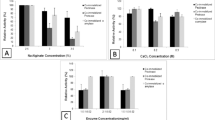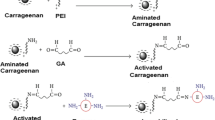Abstract
Endoglucanases are an enzyme of cellulases complex that has a great potential for many technological applications. One of the issues of its use concerns the recovery and reuse of this enzyme. Thus, in this study, the use of a surface-modified kaolin was evaluated to immobilize endoglucanase and evaluate the enzyme activity for its reuse. Kaolin was surface modified with 3-aminopropyltriethoxysilane (APTES) and glutaraldehyde (GA). In addition, the properties of the immobilized enzyme were investigated and compared with those of the free enzyme. Results showed that the optimal pH value of endoglucanase was not affected by the immobilization process but showed a broader range of optimal temperature compared to free enzyme. Immobilization on kaolin allowed fast and easy cellulase recovery with a loss of enzyme activity of only 20% after eight cycles of use. These results indicate that kaolin is a promising substitute to the currently synthetic supports studied for cellulases immobilization with the advantage of being abundant in nature, resistant to microbial attack, chemically and mechanically stable.








Similar content being viewed by others
References
Henrissat B (1994) Cellulases and their interaction with cellulose. Cellulose 1:169–196
Lynd LR, Weimer PJ, van Zyl WH, Pretorius IS (2002) Microbial cellulose utilization: fundamentals and biotechnology. Microbiol Mol Biol Rev 66:506–577
Zhang XZ, Zhang YHP (2013) Cellulases: characteristics, sources, production, and applications.In: Bioprocessing technologies in biorefinery for sustainable production of fuels, chemicals, and polymers, Wiley, Hoboken, pp 131–146
Singh R, Kumar M, Mittal A, Mehta PK (2016) Microbial cellulases in industrial applications. Ann Appl Bio-Sci 3:R23–R29
Sheldon RA (2007) Enzyme immobilization: the quest for optimum performance. Adv Synth Catal 349:1289–1307
Homaei AA, Sariri R, Vianello F, Stevanato R (2013) Enzyme immobilization: an update. J Chem Biol 6:185–205
Eş I, Vieira JDG, Amaral AC (2015) Principles, techniques, and applications of biocatalyst immobilization for industrial application. Appl Microbiol Biotechnol 99:2065–2082
Torres-Salas P, del Monte-Martinez A, Cutiño-Avila B, Rodriguez-Colinas B, Alcalde M, Ballesteros AO, Plou FJ (2011) Immobilized biocatalysts: novel approaches and tools for binding enzymes to supports. Adv Mater 23:5275–5282
Saleem M, Rashid M, Jabbar A, Perveen R, Khalid A, Rajoka M (2005) Kinetic and thermodynamic properties of an immobilized endoglucanase from Arachniotus citrinus. Process Biochem 40:849–855
Ince A, Bayramoglu G, Karagoz B, Altintas B, Bicak N, Arica MY (2012) A method for fabrication of polyaniline coated polymer microspheres and its application for cellulase immobilization. Chem Eng J 189:404–412
Abraham RE, Verma ML, Barrow CJ, Puri M (2014) Suitability of magnetic nanoparticle immobilised cellulases in enhancing enzymatic saccharification of pretreated hemp biomass. Biotechnol Biofuels 7:1–12
Mubarak N, Wong J, Tan K, Sahu J, Abdullah E, Jayakumar N, Ganesan P (2014) Immobilization of cellulase enzyme on functionalized multiwall carbon nanotubes. J Mol Catal B Enzym 107:124–131
Sánchez-Ramírez J, Martínez-Hernández JL, Segura-Ceniceros P, López G, Saade H, Medina-Morales MA, Ramos-González R, Aguilar CN, Ilyina A (2017) Cellulases immobilization on chitosan-coated magnetic nanoparticles: application for Agave Atrovirens lignocellulosic biomass hydrolysis. Bioprocess Biosyst Eng 40:9–22
Zang L, Qiu J, Wu X, Zhang W, Sakai E, Wei Y (2014) Preparation of magnetic chitosan nanoparticles as support for cellulase immobilization. Ind Eng Chem Res 53:3448–3454
Qi H, Duan H, Wang X, Meng X, Yin X, Ma L (2015) Preparation of magnetic porous terpolymer and its application in cellulase immobilization. Polym Eng Sci 55:1039–1045
Lima JS, Araújo PHH, Sayer C, Souza AAU, Viegas AC, de Oliveira D (2017) Cellulase immobilization on magnetic nanoparticles encapsulated in polymer nanospheres. Bioprocess Biosyst Eng 40:511–518
Gao J, Lu C-L, Wang Y, Wang S-S, Shen J-J, Zhang J-X, Zhang Y-W (2018) Rapid immobilization of cellulase onto graphene oxide with a hydrophobic spacer. Catalysts 8:180 (2073-4344)
Wang Y, Chen D, Wang G, Zhao C, Ma Y, Yang W (2018) Immobilization of cellulase on styrene/maleic anhydride copolymer nanoparticles with improved stability against pH changes. Chem Eng J 336:152–159
Su L, Zeng X, He H, Tao Q, Komarneni S (2017) Preparation of functionalized kaolinite/epoxy resin nanocomposites with enhanced thermal properties. Appl Clay Sci 148:103–108
Zdarta J, Meyer AS, Jesionowski T, Pinelo M (2018) A general overview of support materials for enzyme immobilization: characteristics, properties, practical utility. Catalysts 8:92
Sinegani AAS, Emtiazi G, Shariatmadari H (2005) Sorption and immobilization of cellulase on silicate clay minerals. J Colloid Interface Sci 290:39–44
Karagulyan HK, Gasparyan VK, Decker SR (2008) Immobilization of fungal β-glucosidase on silica gel and kaolin carriers. Appl Biochem Biotechnol 146:39–47
Linder M, Mattinen M-L, Kontteli M, Lindeberg G, Ståhlberg J, Drakenberg T, Reinikainen T, Pettersson G, Annila A (1995) Identification of functionally important amino acids in the cellulose-binding domain of Trichoderma reesei cellobiohydrolase I. Protein Sci 4:1056–1064
Ghose T, Bisaria V (1979) Studies on the mechanism of enzymatic hydrolysis of cellulosic substances. Biotechnol Bioeng 21:131–146
Xu J, Sun J, Wang Y, Sheng J, Wang F, Sun M (2014) Application of iron magnetic nanoparticles in protein immobilization. Molecules 19:11465–11486
Kahraman MV, Bayramoğlu G, Kayaman-Apohan N, Güngör A (2007) α-Amylase immobilization on functionalized glass beads by covalent attachment. Food Chem 104:1385–1392
Migneault I, Dartiguenave C, Bertrand MJ, Waldron KC (2004) Glutaraldehyde: behavior in aqueous solution, reaction with proteins, and application to enzyme crosslinking. Biotechniques 37:790–806
Gunda NSK, Singh M, Norman L, Kaur K, Mitra SK (2014) Optimization and characterization of biomolecule immobilization on silicon substrates using (3-aminopropyl) triethoxysilane (APTES) and glutaraldehyde linker. Appl Surf Sci 305:522–530
Barbosa O, Torres R, Ortiz C, Berenguer-Murcia Á, Rodrigues RC, Fernandez-Lafuente R (2013) Heterofunctional supports in enzyme immobilization: from traditional immobilization protocols to opportunities in tuning enzyme properties. Biomacromolecules 14:2433–2462
Hernandez K, Fernandez-Lafuente R (2011) Control of protein immobilization: coupling immobilization and site-directed mutagenesis to improve biocatalyst or biosensor performance. Enzyme Microb Technol 48:107–122
Xu J, Huo S, Yuan Z, Zhang Y, Xu H, Guo Y, Liang C, Zhuang X (2011) Characterization of direct cellulase immobilization with superparamagnetic nanoparticles. Biocatal Biotransform 29:71–76
Yu Y, Yuan J, Wang Q, Fan X, Wang P, Cui L (2014) A promising approach for bio-finishing of cotton using immobilized acid-cellulase. Fibers Polym 15:932–937
Rodrigues RC, Ortiz C, Berenguer-Murcia Á, Torres R, Fernández-Lafuente R (2013) Modifying enzyme activity and selectivity by immobilization. Chem Soc Rev 42:6290–6307
Secundo F (2013) Conformational changes of enzymes upon immobilisation. Chem Soc Rev 42:6250–6261
Zhang W, Qiu J, Feng H, Zang L, Sakai E (2015) Increase in stability of cellulase immobilized on functionalized magnetic nanospheres. J Magn Magn Mater 375:117–123
Zhou J (2010) Immobilization of cellulase on a reversibly soluble—insoluble support: properties and application. J Agric Food Chem 58:6741–6746
Lin Y, Liu X, Xing Z, Geng Y, Wilson J, Wu D, Kong H (2017) Preparation and characterization of magnetic Fe 3 O 4-chitosan nanoparticles for cellulase immobilization. Cellulose 24:5541–5550
Hung T-C, Fu C-C, Su C-H, Chen J-Y, Wu W-T, Lin Y-S (2011) Immobilization of cellulase onto electrospun polyacrylonitrile (PAN) nanofibrous membranes and its application to the reducing sugar production from microalgae. Enzyme Microb Technol 49:30–37
Hartono SB, Qiao SZ, Liu J, Jack K, Ladewig BP, Hao Z, Lu GQM (2010) Functionalized mesoporous silica with very large pores for cellulase immobilization. J Phys Chem C 114:8353–8362
Simon P, Lima JS, Valério A, Oliveira Dd, Araújo PH, Sayer C, Souza AAUd, Souza S (2018) Cellulase immobilization on poly(methyl methacrylate) nanoparticles by miniemulsion polymerization. Braz J Chem Eng 35:649–658
Ó’Fágáin C (2003) Enzyme stabilization—recent experimental progress. Enzyme Microbial Technol 33:137–149
Zhang D, Hegab HE, Lvov Y, Dale Snow L, Palmer J (2016) Immobilization of cellulase on a silica gel substrate modified using a 3-APTES self-assembled monolayer. SpringerPlus 5:1–20
Mishra A, Sardar M (2015) Cellulase assisted synthesis of nano-silver and gold: application as immobilization matrix for biocatalysis. Int J Biol Macromol 77:105–113
Wu L, Yuan X, Sheng J (2005) Immobilization of cellulase in nanofibrous PVA membranes by electrospinning. J Membr Sci 250:167–173
Yu Y, Yuan J, Wang Q, Fan X, Ni X, Wang P, Cui L (2013) Cellulase immobilization onto the reversibly soluble methacrylate copolymer for denim washing. Carbohyd Polym 95:675–680
Yang C, Mo H, Zang L, Chen J, Wang Z, Qiu J (2016) Surface functionalized natural inorganic nanorod for highly efficient cellulase immobilization. R Soc Chem Adv 6:76855–76860
Acknowledgements
The authors would like to thank Coordenação de Aperfeiçoamento de Pessoal de Nível Superior (CAPES) for financial support, as well as Laboratório Central de Microscopia Eletrônica at UFSC (LCME-UFSC) for TEM and SEM analyses.
Author information
Authors and Affiliations
Corresponding author
Additional information
Publisher’s Note
Springer Nature remains neutral with regard to jurisdictional claims in published maps and institutional affiliations.
Rights and permissions
About this article
Cite this article
de Souza Lima, J., Costa, F.N., Bastistella, M.A. et al. Functionalized kaolin as support for endoglucanase immobilization. Bioprocess Biosyst Eng 42, 1165–1173 (2019). https://doi.org/10.1007/s00449-019-02113-w
Received:
Accepted:
Published:
Issue Date:
DOI: https://doi.org/10.1007/s00449-019-02113-w




